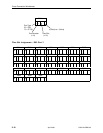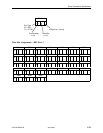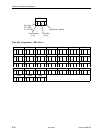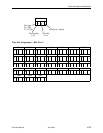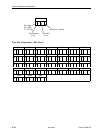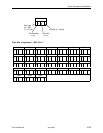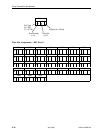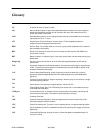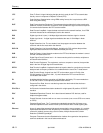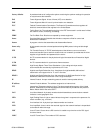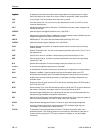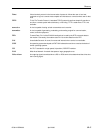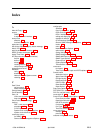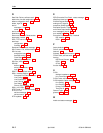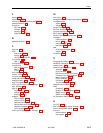
Glossary
GL-2
8700-A2-GB20-00
April 2000
Clear To Send. A signal indicating that the device is ready for the DTE to transmit data.
Usually occurs in response to Request To Send (RTS).
Code Violation. Detected when using HDB3 coding format, this is equivalent to a BPV
when using AMI coding.
Data Communications Equipment. The equipment that provides the functions required to
establish, maintain, and end a connection. It also provides the signal conversion required
for communication between the DTE and the network.
Data Channel LoopBack. Loops the data received from the network interface, for all DS0
channels allocated to the selected port, back to the network.
Digital signal level 0 (zero). A 64 kbps digital telecommunications signal or channel.
Digital signal level 1. A digital signal transmitted at the rate of 1.544 Mbps in North
America.
Digital Subscriber Line. The non-loaded, local-loop copper connection between the
customer and the first node within the network.
Digital Subscriber Line Access Multiplexer. A platform for DSL modems that provides
high-speed data transmission over traditional twisted-pair wiring.
Data Set Ready. A signal from the modem to the DTE that indicates the modem is turned
ON and connected to the DTE.
Digital Signal Cross Connect level 1. An interconnection point for terminals, multiplexers
and transmission facilities.
Data Terminal Equipment. The equipment, such as a computer or terminal, that provides
data in the form of digital signals for transmission.
Data Terminal LoopBack. Loopback mode that loops the data for a particular synchronous
data port back to the port just before it is combined with the rest of the T1 data stream.
Data Terminal Ready. A signal from the DTE to the modem, sent via Pin 20 of the
EIA-232 interface (V.24 circuit 108/1, /2), that indicates the DTE is turned ON and
connected to the modem.
A wideband digital interface operating at 2.048 Mbps, defined by ITU recommendations
G.703 and G.704. It is used primarily outside North America.
Excessive Error Rate. An error rate that is greater than the threshold that has been
configured in the device.
An Electronic Industries Association standard for a high-speed, 25-position, DCE/DTE
interface.
Embedded Operations Channel. An in-band channel between DSL devices, used for
8 kbps management data.
Errored Seconds. A second with one or more error events (one or more CRC error events
or OOFs).
Extended SuperFrame. The T1 transmission standard that specifies 24 frames as an
extended superframe to be used for frame synchronization and to locate signaling bits.
A type of network that supports high-speed communication among systems. It is a widely
implemented standard for LANs. All hosts are connected to a coaxial cable where they
contend for network access using a Carrier Sense, Multiple Access with Collision
Detection (CSMA/CD) paradigm.
European Telecommunications Standardization Institute. An organization that produces
technical standards in the area of telecommunications.
CTS
CV
DCE
DCLB
DS0
DS1
DSL
DSLAM
DSR
DSX-1
DTE
DTLB
DTR
E1
EER
EIA-530-A
EOC
ES
ESF
Ethernet
ETSI



